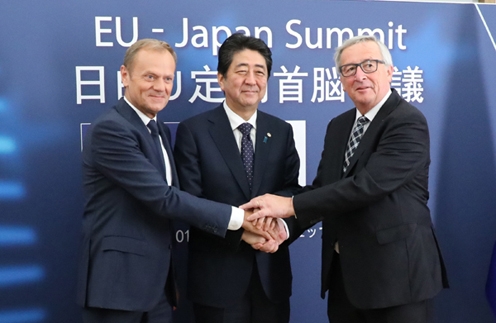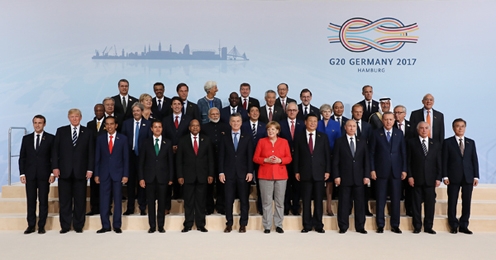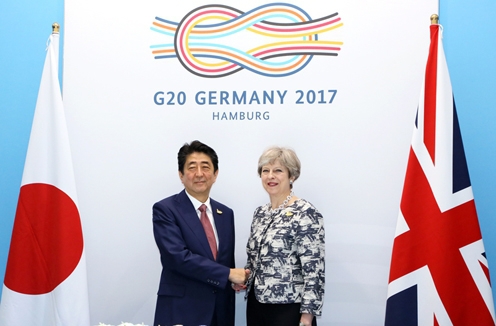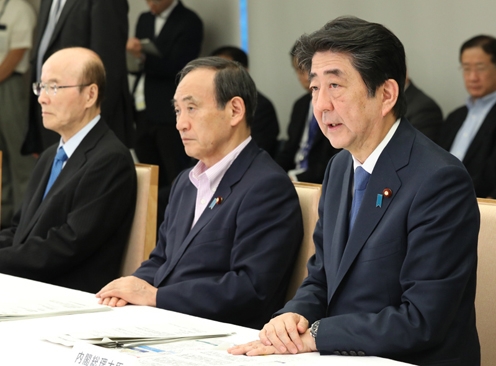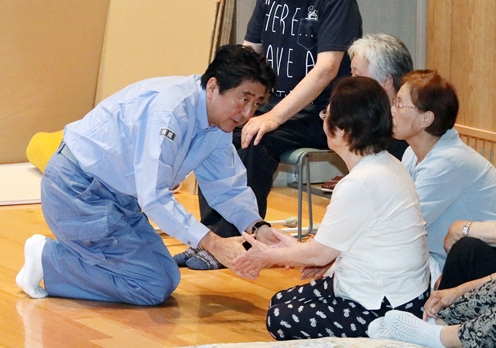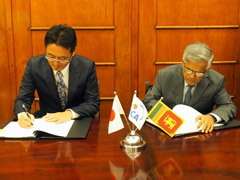Visit to Belgium and Germany
Cabinet Secretariat, Thursday, July 06, 2017
On July 5 (local time), Prime Minister Shinzo Abe visited Brussels in the Kingdom of Belgium.
The Prime Minister first attended a dinner with H.E. Mr. Charles Michel, Prime Minister of the Kingdom of Belgium.
On the following day, July 6 (local time), Prime Minister Abe held talks and a joint press announcement with H.E. Mr. Jens Stoltenberg, Secretary General of the North Atlantic Treaty Organization (NATO).
Following this, the Prime Minister held the Japan-EU Summit Meeting and a joint press conference with H.E. Mr. Donald Tusk, President of the European Council, and H.E. Mr. Jean-Claude Juncker, President of the European Commission, from the European Union, and attended a luncheon.
In the afternoon, the Prime Minister held a meeting with a delegation of Diet members from the Headquarters for the Japan-EU and Other Economic Partnership Agreements and with agricultural organizations.
Afterwards, the Prime Minister visited Hamburg in the Federal Republic of Germany and held talks with the Honorable Donald Trump, President of the United States of America, and H.E. Mr. Moon Jae-in, President of the Republic of Korea.
Prime Minister Shinzo Abe's Article contributed to Handelsblatt (Germany)
Foreign Affairs, Wednesday, July 05, 2017
provisional translation
I am visiting Hamburg to attend the G20 Summit as my second visit to Germany this year, having attended CeBIT in March. Being a Partner Country for CeBIT, Japan had its biggest pavilion ever, featuring 118 Japanese companies. I hope you all remember.
Germany and Japan share basic values such as freedom, democracy, human rights and the rule of law. Further, both countries consider diligence as a virtue, attach importance to manufacturing industries, have industries that are growing worldwide through technological strength and boast strong small- and medium-sized enterprises (SMEs). In Japan we all know that German products have an established reputation. To name one example, German brands account for 30% of the cars in such central Tokyo wards as Minato Ward, where incomes are high, and Shibuya Ward, where I have a private residence. Going beyond consumers, every year, there are Japanese SMEs that participate in the Hannover Messe trade fair seeking German partners.
Sustainability is the theme of this year’s G20 Summit. The international community is strengthening initiatives to achieve the shared target of the Sustainable Development Goals (SDGs). To this end, Japan last year launched its whole-of-government SDGs Promotion Headquarters, which I chair.
To bring about global sustainability, I believe the environment, health and Africa stand as core pillars. The keys to the solution are technological prowess and innovation, which are the very strengths of both Japan and Germany. This is exactly why I wish to have deepened collaboration between the two countries.
The Earth, on which the survival of humankind relies, has long been under multiple threats from global warming. As climate change affects all people the world over, all of us living now bear the responsibility of tackling it for the sake of future generations. The world must unite as one and take actions urgently. World leaders gathered in Paris even immediately after the terror attacks to adopt the Paris Agreement because we all shared this view.
Half a century ago, Japan’s rapid economic growth resulted in environmental pollution. Fundamental to overcoming this situation has been the determination of all the Japanese people to restore our clean air and water and to protect nature by making full use of our technology and social investment. Further, this technology and investment later evolved into Japan’s new engine for growth.
Amidst a series of oil shocks, price hikes for natural resources economically justified the investment in energy conservation. Further, developing energy-efficient cars and increasing factory productivity boosted the competitiveness of Japanese products. For instance, the thermal efficiency of the steel manufacturing plant where I myself worked at when I was in my 20s became one of the highest in the world.
Now, we are eager to fully utilize Japan’s technological strength to protect the Earth for future generations. We have committed to reducing Japan’s greenhouse gas emissions by 26% by fiscal year 2030 even though we already have lower emissions than other countries. There are a variety of our technologies that we wish to be utilized by many around the world by putting them into practical application, aiming at a hydrogen-based society. They range from fuel-cell vehicles and safe transport systems for liquid hydrogen to power supplies that combine solar panels and LEDs.
Turning our eyes to developing countries, Japan contributes to the introduction of infrastructure that is well tailored to each country’s conditions. In Kenya, we assist with the supply of electricity using geothermal turbines, while in Papua New Guinea, we provide assistance in training human resources to manage forestry resources and greenhouse gas emissions systems. Further, under the Paris Agreement, we have promoted low-carbon technologies in developing countries by expanding the number of partner countries in the Joint Crediting Mechanism (JCM) to 17. Examples include installing high efficient boilers in Mongolia and solar energy systems in Palau. While achieving such tangible results, I will keep my promise given at COP21 to realize climate change programs in developing countries worth 1.3 trillion yen by 2020.
To achieve sustainability, people need to stay healthy to come into their own. Health is the key to a society that respects human life and leaves no one behind. Following the major Ebola virus disease outbreak in 2014, my focus was not limited only to fighting against infectious diseases. Instead, it goes beyond that, to the reinforcement of health as a “system,” including elements such as leadership and governance as preventive measures, health information, health workers, medicines and medical devices, and to strengthening responses to public health emergencies.
At the G7 Ise-Shima Summit in May 2016, in their statement the “G7 Ise-Shima Vision for Global Health,” the G7 leaders committed to concrete actions on major themes, such as universal health coverage (UHC) and strengthening the international community’s capacity to respond to public health emergencies including infectious diseases.
When I visited Kenya to co-host the Sixth Tokyo International Conference on African Development (TICAD VI) in August 2016, I proposed “the promotion of resilient health systems” as a priority agenda item. Accordingly, we have steadily implemented assistance in Africa, including strengthening preparation and response measures against public health emergencies and strengthening UHC promotion. In Ghana, for example, Japan promotes the health of the local people by combining the development and provision of facilities and equipment together with the dispatch of specialists. In one case, community health nurses have been stationed in rural districts lacking access to medical services.
Improving health is equally crucial for developed countries where the population ages relentlessly. It holds the key to sustainability. In that regard, we have embarked on applying innovation in digital technology to the vast quantity of health data so as to develop systems that address health management, prevention, treatment and nursing care in an integrated manner. This not only helps in maintaining people’s good health but also provides a solution to the growing medical expenses stemming from the aging society. Through these efforts, Japan is determined to lead the way as a trail-blazer in solving the challenges of aging that both developed and emerging economies face.
It’s no exaggeration to say that global sustainability cannot be achieved without sustainability in Africa, the continent with the most potential in the world. Meanwhile, lack of water and food, underinvestment in infrastructure, lagging education and training, and political instability have all impeded the opening up of Africa’s enormous potential.
We, both the government and private sector entities, are fully convinced of the importance of African sustainability and thus have continuously contributed to Africa’s development. Back in 1993, Japan launched the TICAD process with the participation of African leaders, and more than 200 companies from Japan joined its sixth meeting, held in Kenya last year. Japan’s motto is “investing from Japan into Africa, furnishing African people with technologies and skills, sharing with them production methods and work discipline, and with them, letting African people feel the economic self-reliance and the significance of working, and enabling them to have their own industries.” Enhancing African indigenous industries will also enable young Africans to remain in their own countries.
Today, the manufacturing industry is burgeoning in Africa, and the Japanese term “kaizen,” the process of workers onsite continuously brainstorming ideas to improve productivity, is spreading. We are willing to accept more students and trainees from Africa on an ongoing basis. Further collaboration is on the way in the agricultural sector, in which African leaders asked for more support, in every phase such as infrastructure, technology and human resources.
Lastly, I have a favor to ask our German friends. Please come and visit Japan! Last year, of the 24 million foreign visitors to Japan, only 180,000, or 0.8%, were from Germany. Let me say again, there are many Japanese fans of Germany in areas ranging widely from business, academia, the arts and sports to tourism.
This weekend, the G20 leaders will gather to solve the challenges confronting the world under the leadership of Chancellor Merkel. I look forward to having frank, open-minded and rich discussions there.
G20 Hamburg Summit: First Day
Cabinet Secretariat, Friday, July 07, 2017
[Provisional Translation]
On July 7 (local time), Prime Minister Shinzo Abe visited Hamburg in the Federal Republic of Germany to attend the G20 Summit on Financial Markets and the World Economy and other events.
The Prime Minister first held talks with H.E. Mr. Moon Jae-in, President of the Republic of Korea, and was then welcomed by H.E. Dr. Angela Merkel, Federal Chancellor of Germany. Following this, the Prime Minister attended a retreat on the theme of “Countering Terrorism” and a commemorative photograph session, and later attended Session 1 (Working Lunch) on “Economic Growth and Trade.”
In the afternoon, Prime Minister Abe held talks with H.E. Mr. Narendra Modi, Prime Minister of India, and H.E. Mr. Recep Tayyip Erdogan, President of the Republic of Turkey, respectively.
Afterwards, the Prime Minister attended Session 2 on “Development, Climate Change and Energy,” and then held talks with H.E. Mr. Vladimir Vladimirovich Putin, President of the Russian Federation.
In the evening, the Prime Minister enjoyed a concert and attended a dinner banquet hosted by Chancellor Merkel and her spouse.
G20 Hamburg Summit: Second Day
Cabinet Secretariat, Saturday, July 08, 2017
[Provisional Translation]
On July 8 (local time), Prime Minister Shinzo Abe, who is visiting Hamburg in the Federal Republic of Germany to attend the G20 Summit on Financial Markets and the World Economy and other events, held talks respectively with H.E. Dr. Xi Jinping, President of the People’s Republic of China; the Rt. Hon. Theresa May, MP, Prime Minister of the United Kingdom; and H.E. Mr. Lee Hsien Loong, Prime Minister of the Republic of Singapore.
Following this, the Prime Minister attended Session 3 on “Africa, Migration and Health” and then held talks with H.E. Ms. Erna Solberg, Prime Minister of the Kingdom of Norway. Subsequently, the Prime Minister attended Session 4 (Working Lunch) on “Digitalization, Women’s Empowerment and Employment.”
In the afternoon, the Prime Minister held talks with the Honorable Donald Trump, President of the United States of America, and then attended the closing session.
Meeting of the Ministerial Council on the Torrential Rains in Fukuoka Prefecture, Oita Prefecture, and Other Regions
Cabinet Secretariat, Tuesday, July 11, 2017
[Provisional Translation]
Prime Minister Shinzo Abe attended a Meeting of the Ministerial Council on the Torrential Rains in Fukuoka Prefecture, Oita Prefecture, and Other Regions at the Prime Minister’s Office.
At the meeting, there was a report on the state of damage and the status of the Government’s response.
Based on the report, the Prime Minister said,
“Firstly, I would like to offer my heartfelt condolences for the victims who passed away as a result of the river flooding and landslides caused by the recent torrential rains, and extend my sympathies to the bereaved families. I would also like to express my sympathies to all those injured or affected by this disaster.
More than 20 people are still missing, and a force of about 12,000 people, comprising rescue teams of the Self-Defense Forces (SDF), police, fire departments, and the Japan Coast Guard, are now working hard to carry out rescue and relief activities. I would like them all to continue to exert their full efforts in thorough search activities, keeping in mind the feelings of the families, who are praying for the safety of the missing people, while paying due care to secondary disasters.
In the disaster-affected areas, many people are living in a restricted, unsettled manner in evacuation shelters. As the weather continues to grow considerably hotter, measures to counteract the heat in the evacuation shelters are an urgent issue. We must thoroughly grasp the needs of the people affected by the disaster, and rapidly implement support that considers their sensitivities.
Further, we will clear away driftwood and restore roads and other infrastructure, which are currently obstacles to the rescue activities and lifeline restoration, and exert our full efforts in securing housing and other matters, so that those affected by the disaster can rebuild their lives as quickly as possible.
I would like each of you to exert leadership and press ahead to carry out measures in response to the situation that is changing one minute to the next.
If local conditions permit, I would like to visit Fukuoka Prefecture and Oita Prefecture tomorrow to see the actual situation for myself and to directly hear the views of those affected. In order to resolve the difficult situation as quickly as possible, I would like the Abe Cabinet to work as one to exert our full efforts to advance measures, in sympathy for all those affected by the disaster.”
Visits to Oita Prefecture and Fukuoka Prefecture (Inspection of the State of Damage Caused by the Torrential Rains Resulting from Typhoon No. 3 and the Seasonal Rain Front)
Cabinet Secretariat, Wednesday, July 12, 2017
[Provisional Translation]
Prime Minister Shinzo Abe visited Oita Prefecture and Fukuoka Prefecture for an inspection of the state of damage caused by the torrential rains resulting from Typhoon No. 3 and the seasonal rain front.
First, after observing the site of a collapsed railway bridge of the JR Kyudai Line, which spanned the Kagetsu River in Hita City, Oita Prefecture before the collapse, the Prime Minister visited an evacuation shelter.
Next, the Prime Minister visited Hita City Hall, and held an exchange of views with Mr. Katsusada Hirose, Governor of Oita Prefecture; Mr. Keisuke Harada, Mayor of Hita City; Mr. Masanori Okuzuka, Mayor of Nakatsu City; and others.
Following this, the Prime Minister visited Toho Village Hall in Fukuoka Prefecture and, after receiving an explanation of the damage situation and the state of recovery, visited an evacuation shelter. Next, the Prime Minister visited the disaster-affected area of Hakihoshimaru in Asakura City and offered a silent prayer.
Finally, Prime Minister Abe visited Asakura City Hall, and held an exchange of views with Mr. Hiroshi Ogawa, Governor of Fukuoka Prefecture; Mr. Shunsuke Morita, Mayor of Asakura City; and others.
After visiting the disaster-affected areas, the Prime Minister said,
“Firstly, I would like to offer my condolences for the victims who passed away as a result of the torrential rains and my heartfelt sympathies to their families. I would also like to express my sympathies to all those affected by this disaster.
From immediately after the onset of the disaster, members of the Self-Defense Forces (SDF), police, fire departments, and the Japan Coast Guard have been exerting their full efforts in emergency disaster response, from day to night, placing themselves in danger of secondary disasters. Even now, a force of over 10,000 people is working hard to carry out search activities. However, there are still many people missing. We will continue to exert our full efforts in search, rescue, and relief activities, keeping in mind the feelings of the families, who are praying for the safety of the missing people.
At the evacuation shelters, I heard directly the feelings of anxiety of those affected, and their experiences of great hardship. The frontlines are of the greatest importance. Paying the utmost attention to these frontlines, the Government will work as one. We will exert our full efforts to provide daily life support that meets the needs of the areas and of the people affected by this disaster, such as installing air conditioners in the evacuation shelters, securing housing, and removing the driftwood that is obstructing the recovery and reconstruction. Further, so that all those affected can regain a life lived with peace of mind as quickly as possible, we will exert our full efforts in recovery and reconstruction.
I saw for myself how bridges, roads, and cherished homes have been washed away, and the large amount of driftwood that has piled up. I confirmed the immensity of the damage. I intend to designate this disaster as a ‘Disaster of Extreme Severity’ as soon as possible. To that end, the national Government and local governments will work as one to advance the work in as short a time as possible.
In addition, tomorrow we will determine the boost in the provision of grant tax funds. In any event, the Government will provide full support that enables the local governments to carry out recovery and reconstruction without hesitation and with peace of mind regarding financing.”
Signing of Japanese ODA Loan Agreements with Sri Lanka: Building infrastructure to reduce regional disparities through living environment improvements
JICA, Monday, July 10, 2017
On July 7, 2017, the Japan International Cooperation Agency (JICA) signed loan agreements with the Government of the Democratic Socialist Republic of Sri Lanka in Colombo to provide Japanese ODA loans of up to a total of 44.767 billion yen for two projects.
Since civil war ended in 2009 after 26 years of fighting, Sri Lanka has made considerable effort in reconstruction and achieved steady economic growth, driven by growth in service industries, such as tourism. As a result, the GNI (Gross National Income) per capita is approaching that of upper-middle-income countries. Nevertheless, a large economic gap remains between Colombo, which is the political and economic center of the country, and outlying areas, including conflict-affected areas. Even inside urban areas, disparities have arisen due to an imbalance in infrastructure development. Given these circumstances, infrastructure enhancement is critical to improve the living environment in order to address the regional disparities and achieve inclusive growth which benefits all of the people of Sri Lanka.
A summary of the two Japanese ODA projects provided by the loan agreements is as follows:
(1) Rural Infrastructure Development Project in Emerging Regions (loan amount: 12.957 billion yen)
(2) Kalu Ganga Water Supply Expansion Project (I) (loan amount: 31.81 billion yen)
Details for the projects are provided below.
(1) Rural Infrastructure Development Project in Emerging Regions
(a) Objective and Summary
The objective of the project is to raise living standards and to develop the livelihoods of local people through improvements to basic infrastructure, such as rural roads, medium and small-size irrigation and potable water supply facilities in Northern, Eastern, North Central and Uva Provinces that include conflict-affected areas, thereby contributing to development of rural economies, reduction of regional disparities, and alleviation of poverty in the country.
(b) Background and Necessity
Since the end of civil war in 2009, Sri Lanka has achieved remarkable economic growth. However, the provision of basic infrastructure directly related to the lives and production activities of local people such as rural roads, medium and small-size irrigation and potable water supply facilities, has not developed sufficiently in Northern, Eastern, North Central and Uva Provinces. For example, only five percent of the rural roads are paved in North Central Province, where the infrastructure is relatively developed compared to the other three target provinces. Further, in the dry season, only around 50 percent of the cultivated areas are available for agricultural activities compared to those in the rainy season due to the deterioration and underdevelopment of irrigation facilities in the four target provinces. In addition, a large number of households have to obtain drinking water away from their homes, as in the case of Northern Province where nearly 50 percent of the households are facing these challenges. An absence or poor condition of such basic infrastructure is one of the factors hindering improvement of living standards and the livelihoods of the local people, resulting in serious regional disparities, including a large gap in the poverty rates between Western Province and the four target provinces.
Taking these circumstances into account, the project will carry out the construction and rehabilitation of rural roads (concrete pavement, roadway widening, culverts and bridges) and of medium and small-size irrigation facilities (embankments, drain ditches, sluice gates and watercourses). The project will also perform the construction and rehabilitation of potable water supply facilities (wells, pumps, reservoirs, transmission pipes and water treatment devices).
(c) Executing Agency
Ministry of Provincial Councils and Local Government
Address: No. 330, Dr. Colvin R. de Silva Mawatha (Union Place), Colombo 02, Sri Lanka
Phone: +94-11-230-5326, fax: +94-11-234-7529
(d) Planned Implementation Schedule
1. Completion of project: September 2021 – when the facilities are put into service
2. Issuing of letters of invitation for consulting services (including detailed design work): October 2017
3. Tender announcement of initial procurement package for international competitive bidding on project construction: Domestic procurement is planned, and international competitive bidding for procurement is not planned for this project.
(2) Kalu Ganga Water Supply Expansion Project (I)
(a) Objective and Summary
The objective of the project is to improve access to safe water and water supply efficiency in the southern area of Western Province by expanding the Kalu Ganga water supply facilities and restructuring water distribution networks, thereby contributing to improvement in the living conditions of the project area.
(b) Background and Necessity
Western Province is the center of Sri Lanka’s political and economic activities, as around 42 percent of GDP (Gross Domestic Products) and 28.5 percent of the population is concentrated in this area. The province has been leading economic development with industrial complexes, export processing zones, and the largest international airport in the country. Although the infrastructure is relatively advanced and the water supply coverage is 62.7 percent, higher than the national average of 45.9 percent, communities without water supply systems remain in the province outside of Colombo District. It is predicted that urbanization will further progress and that the water demand will grow, making an expansion to the water supply services necessary in the province. Moreover, deterioration of the water distribution pipes has resulted in high non-revenue water rates of 30 to 40 percent caused by leaks, illegal connections, and uninstalled meters. To address the rising demand for water, it is essential that the non-revenue water rates are reduced for a more efficient water supply.
Taking these circumstances into account, the project will provide water supply systems, including an expansion of the water treatment plants, and installation of intake facilities, transmission and distribution pipes. The project will also launch a pilot project for reducing non-revenue water. The project will contribute to strengthening the water supply capacity in the southern areas in Western Province for a safe, stable water supply.
(c) Executing Agency
Ministry of City Planning and Water Supply
Address: No. 35, New Parliament Road, Pelawatta, Battaramulla, Sri Lanka
Phone: +94-11-217-7240, fax: +94-11-217-7242
(d) Planned Implementation Schedule
1. Completion of project: March 2024 – when the facilities are put into service
2. Issuing of letters of invitation for consulting services (including detailed design work): October 2017
3. Tender announcement of initial procurement package for international competitive bidding on project construction:
Package titles:
• Intake & Water Treatment Plant Facilities
• Transmission & Distribution Feeder Main Pipes
• Reservoirs & Pump Stations
Release date: September 2019


























